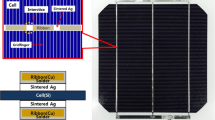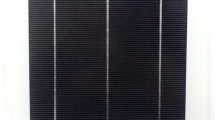Abstract
The requirement for environmentally friendly technology has led to considerable efforts to develop photovoltaic (PV) modules. The copper (Cu) ribbon interconnects of PV modules require alternative bonding materials to replace the current solder that contains lead. Several candidate lead-free solder materials have been developed that are inexpensive and reliable. In this study, we evaluate Cu ribbon interconnection bonding with Sn–0.7Cu and Sn–48Bi–2Ag solder materials to address their feasibility for use in PV modules by investigating material degradation during thermal cycling. After thermal cycling, in the Sn–0.7Cu solder, considerable intermetallic compound (IMC) growth occurred at both interfaces, while Bi-rich grains coarsened with IMC growth in Sn–48Bi–2Ag solder. However, the degradation of the electrical performance of the PV modules was similar for those containing both solder materials. Cracks that appeared at the interface propagated from the fractures of the Ag3Sn IMC layers. This suggests that preventing IMC growth at the interface between the Cu ribbon and Ag sintered electrode is important to improve the reliability of interconnects in PV modules. The use of Pb-free solder in PV modules opens up a novel opportunity to realize high reliability at low cost.







Similar content being viewed by others
References
G.N. Tiwari, R.K. Mishra, S.C. Solanki, Appl. Energy 88, 2287 (2011)
M.A. Green, K. Emery, Y. Hishikawa, W. Warta, E.D. Dunlop, Prog. Photovolt. Res. Appl. 23, 1 (2015)
V. Sharma, S.S. Chandel, Renew. Sustain Energy Rev. 27, 753 (2013)
A. Ndiaye, A. Charki, A. Kobi, C.M.F. Kébé, P.A. Ndiaye, V. Sambou, Sol. Energy 96, 140 (2013)
M.M. Aman, K.H. Solangi, M.S. Hossain, A. Badarudin, G.B. Jasmon, H. Mokhlis, A.H.A. Bakar, S.N. Kazi, Renew. Sustain Energy Rev. 41, 1190 (2015)
W. Zhang, W. Ruythooren, J. Electron. Mater. 37, 1095 (2008)
J.-S. Jeong, N. Park, C. Han, Microelectron. Reliab. 52, 2326 (2012)
U. Itoha, M. Yoshidaa, H. Tokuhisaa, K. Takeuchib, Y. Takemurab, Energy Procedia 55, 464 (2014)
N. Park, J.-S. Jeong, C. Han, Microelectron. Reliab. 54, 1562 (2014)
P. Schmitt, P. Kaiser, C. Savio, M. Tranitz, U. Eitner, Energy Procedia 27, 664 (2012)
H.-H. Hsieh, F.-M. Lin, F.-Y. Yeh, M.-H. Lin, Sol. Energy Mater. Sol. Cells 93, 864 (2009)
T.L. Yang, K.Y. Huang, S. Yang, H.H. Hsieh, C.R. Kao, Sol. Energy Mater. Sol. Cells 123, 139 (2014)
IEC 61215, Crystalline silicon terrestrial photovoltaic (PV) modules—Design qualification and type approval (2005)
IEC 60904-1, Photovoltaic devices—Part 1: Measurement of photovoltaic current–voltage characteristics (2006)
C.R. Kao, Mater. Sci. Eng. A 238, 196 (1997)
R.W. Wu, L.C. Tsao, S.Y. Chang, C.C. Jain, R.S. Chen, J. Mater. Sci. Mater. Electron. 22, 1181 (2011)
J.F. Li, P.A. Agyakwa, C.M. Johnson, Acta Mater. 58, 3429 (2010)
J.F. Li, S.H. Mannan, M.P. Clode, D.C. Whalley, D.A. Hutt, Acta Mater. 54, 2907 (2006)
H.R. Kotadia, P.D. Howes, S.H. Mannan, Microelectron. Reliab. 54, 1253 (2014)
W.R. Osório, L.C. Peixoto, L.R. Garcia, N. Mangelinck-Noël, A. Garcia, J. Alloys Compd. 572, 97 (2013)
K.-J. Chen, F.-Y. Hung, T.-S. Lui, L.-H. Chen, D.-W. Qiu, T.-L. Chou, Microelectron. Eng. 116, 33 (2014)
T. Siewert, S. Lin, D.R. Smith, J.C. Madeni, Properties of lead-free solders, http://www.metallurgy.nist.gov/solder/NIST_LeadfreeSolder_v4.pdf. Accessed 1 June 2015
Acknowledgments
The authors are grateful for the support from the New & Renewable Energy Program of the Korea Institute of Energy Technology Evaluation and Planning (KETEP) funded by the Korea Government Ministry of Knowledge Economy (20133030011110).
Author information
Authors and Affiliations
Corresponding author
Rights and permissions
About this article
Cite this article
Oh, C., Kim, A., Kim, J. et al. Bonding copper ribbons on crystalline photovoltaic modules using various lead-free solders. J Mater Sci: Mater Electron 26, 9721–9726 (2015). https://doi.org/10.1007/s10854-015-3640-9
Received:
Accepted:
Published:
Issue Date:
DOI: https://doi.org/10.1007/s10854-015-3640-9




